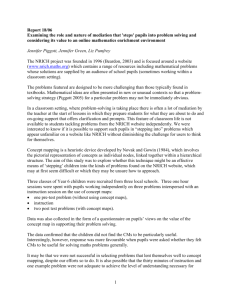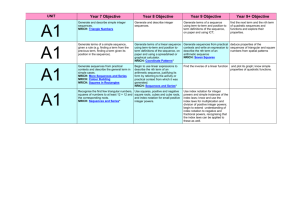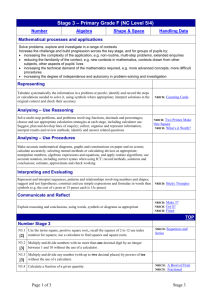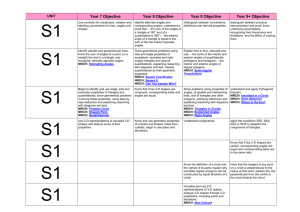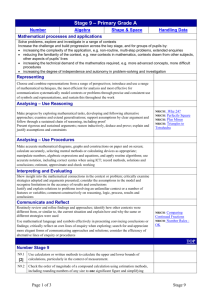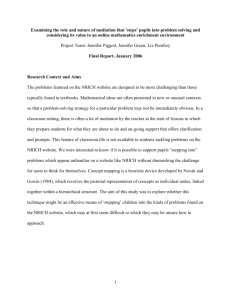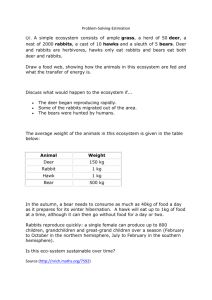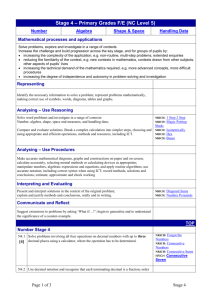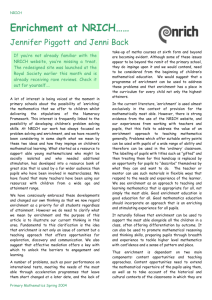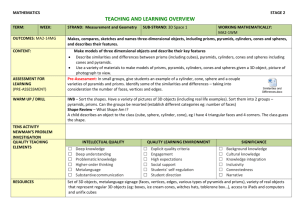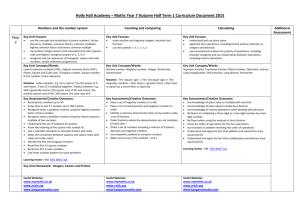Stage 1
advertisement
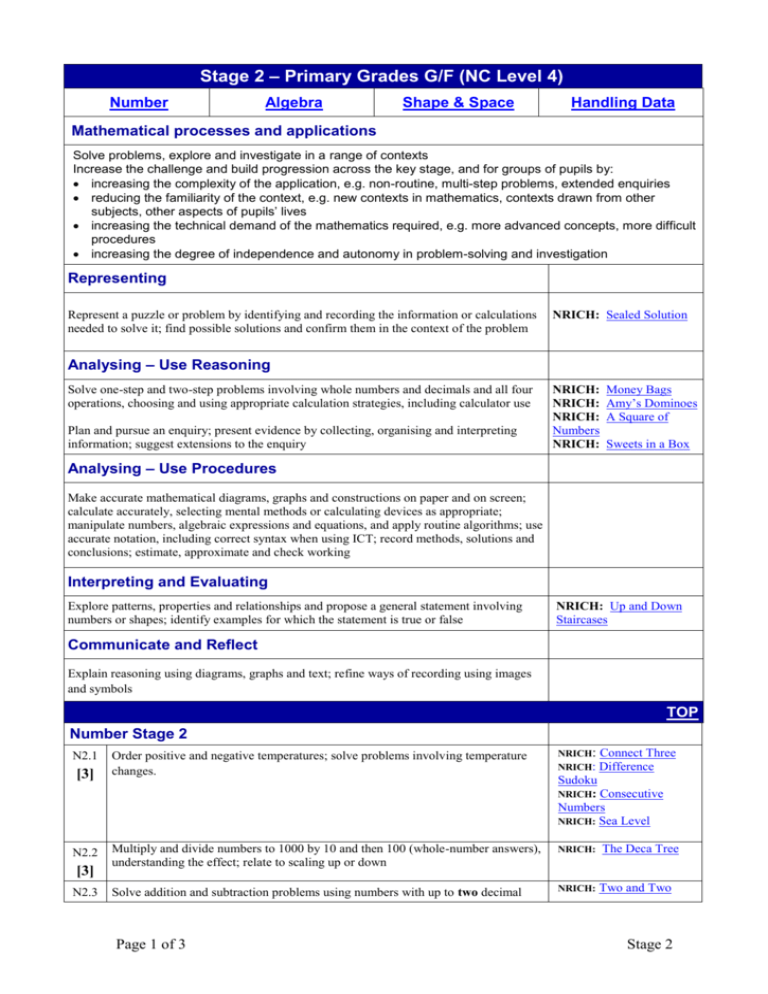
Stage 2 – Primary Grades G/F (NC Level 4) Number Algebra Shape & Space Handling Data Mathematical processes and applications Solve problems, explore and investigate in a range of contexts Increase the challenge and build progression across the key stage, and for groups of pupils by: increasing the complexity of the application, e.g. non-routine, multi-step problems, extended enquiries reducing the familiarity of the context, e.g. new contexts in mathematics, contexts drawn from other subjects, other aspects of pupils’ lives increasing the technical demand of the mathematics required, e.g. more advanced concepts, more difficult procedures increasing the degree of independence and autonomy in problem-solving and investigation Representing Represent a puzzle or problem by identifying and recording the information or calculations needed to solve it; find possible solutions and confirm them in the context of the problem NRICH: Sealed Solution Analysing – Use Reasoning Solve one-step and two-step problems involving whole numbers and decimals and all four operations, choosing and using appropriate calculation strategies, including calculator use Plan and pursue an enquiry; present evidence by collecting, organising and interpreting information; suggest extensions to the enquiry NRICH: NRICH: NRICH: Numbers NRICH: Money Bags Amy’s Dominoes A Square of Sweets in a Box Analysing – Use Procedures Make accurate mathematical diagrams, graphs and constructions on paper and on screen; calculate accurately, selecting mental methods or calculating devices as appropriate; manipulate numbers, algebraic expressions and equations, and apply routine algorithms; use accurate notation, including correct syntax when using ICT; record methods, solutions and conclusions; estimate, approximate and check working Interpreting and Evaluating Explore patterns, properties and relationships and propose a general statement involving numbers or shapes; identify examples for which the statement is true or false NRICH: Up and Down Staircases Communicate and Reflect Explain reasoning using diagrams, graphs and text; refine ways of recording using images and symbols TOP Number Stage 2 N2.1 [3] N2.2 [3] N2.3 Order positive and negative temperatures; solve problems involving temperature changes. NRICH: Connect Three NRICH: Difference Multiply and divide numbers to 1000 by 10 and then 100 (whole-number answers), understanding the effect; relate to scaling up or down NRICH: The Deca Tree Solve addition and subtraction problems using numbers with up to two decimal NRICH: Two and Two Page 1 of 3 Sudoku NRICH: Consecutive Numbers NRICH: Sea Level Stage 2 [5] places in the context of measurement or money, without the use of a calculator. NRICH: How Many Miles to Go? NRICH: N2.4 [5] Solve multiplication and division problems involving multiplication of up to a twodigit number by a one-digit number, without the use of a calculator. N2.5 Solve division problems, interpreting the result. Reach 100 MFL3 NRICH: Twenty Divided by Six [3] N2.6 [3] N2.7 [3] Convert ½ and ¼ to and from percentage form and calculate 25%, 50% of simple quantities, including money; read and estimate percentages from percentage scales and scaled pie charts. Identify fractions; recall the fraction to decimal conversions of familiar simple fractions. TOP Algebra Stage 2 A2.1 Recognise and describe patterns in number. [4] NRICH: NRICH: NRICH: NRICH: Triangle Numbers Swimming Pool Tug Harder! First Connect Three A2.2 Use word formulae in context; substitute positive integers into the formula to find [4] the value of the subject. TOP Shape Stage 2 S2.1 Estimate lengths and angles by comparison. [3] S2.2 Use kilograms and grams and convert measurements from one unit to another. [3] [4] Measure and draw angles to the nearest degree; distinguish between acute, obtuse, reflex and right angles. NRICH: Six Places to Visit NRICH: How Safe Are S2.4 Recognise simple solids and their nets. NRICH: Square It NRICH: Cut Nets NRICH: A Puzzling Cube NRICH: Let’s Reflect S2.3 [5] S2.5 Recognise and complete reflection symmetry of 2-D shapes. You? [4] S2.6 [5] Use and interpret street plans (including simple grid references, left and right, clockwise and anticlockwise, and compass directions). TOP Data Stage 2 D2.1 Understand and use the probability scale. [4] D2.2 Find the mode and median value of a small set of discrete data. [4] D2.3 Extract and use information from common two-way tables including timetables. Page 2 of 3 Stage 2 [4] TOP Page 3 of 3 Stage 2
